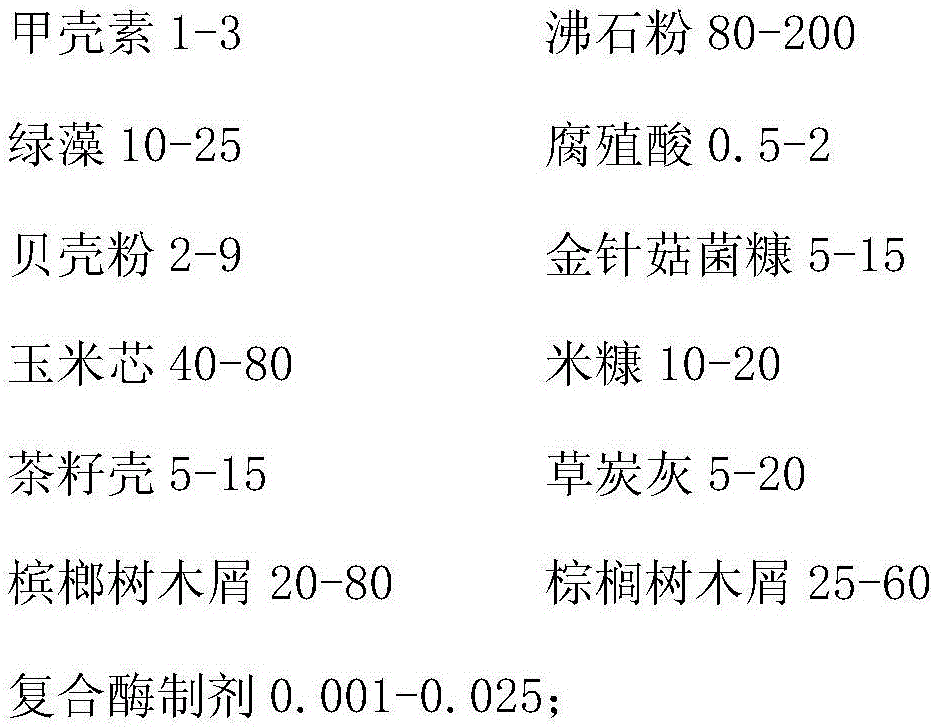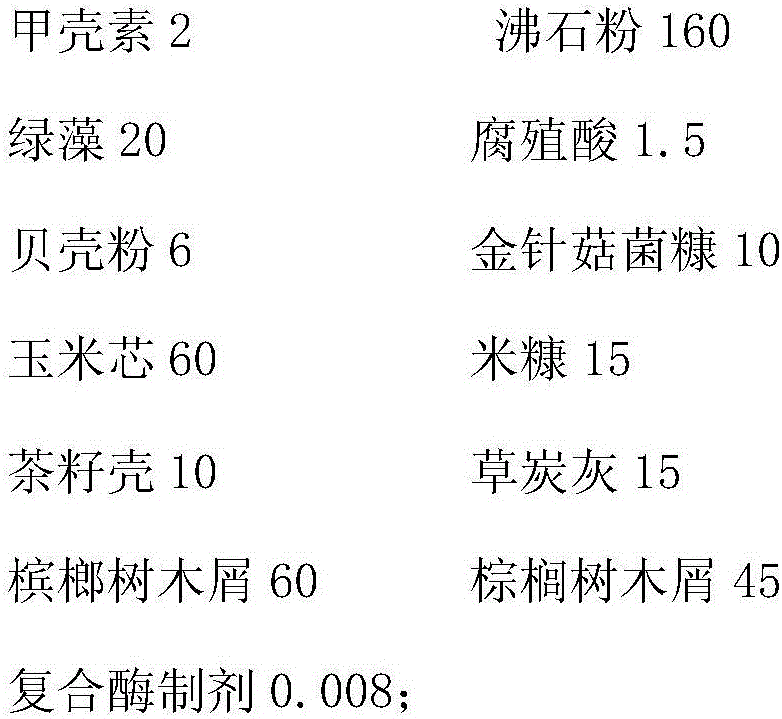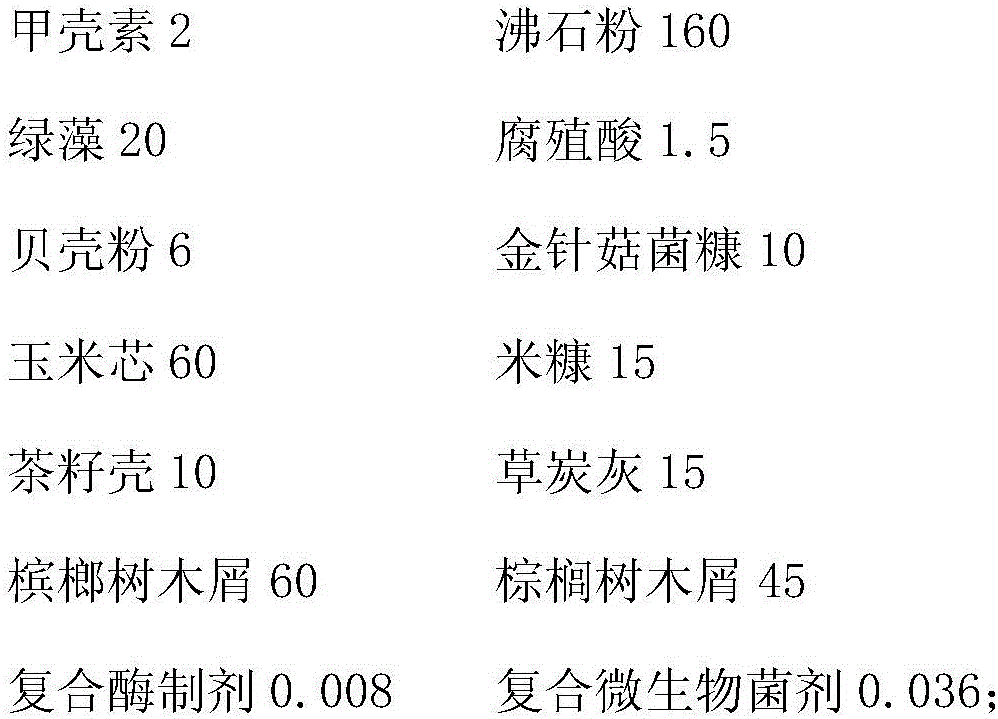Polycyclic aromatic hydrocarbon-polluted soil restoration material
A soil remediation, polycyclic aromatic hydrocarbon technology, applied in the field of soil remediation
- Summary
- Abstract
- Description
- Claims
- Application Information
AI Technical Summary
Problems solved by technology
Method used
Image
Examples
Embodiment 1
[0083] Take the soil sample polluted by polycyclic aromatic hydrocarbons, and then take the soil remediation agent according to the ratio of 50 grams of soil remediation agent per 1000 grams of soil sample;
[0084] Add the following raw materials to the soil sample: chitin, zeolite powder, green algae, humic acid, shell powder, enoki mushroom chaff, corn cob, rice bran, tea seed shell, peat ash, betel nut wood chips, palm tree chips;
[0085] The parts by weight of each raw material are as follows:
[0086]
[0087] Mix with soil samples and keep for 48 hours;
[0088] The bacterium powder that the present invention adopts, enzyme are all derived from commercially available;
[0089] Chlorella is dried and pulverized algal powder with a water content of about 3%;
[0090] Corn cobs are dried and crushed granules with a water content of about 4%;
[0091] Its moisture content of peat ash is about 3%; The following examples are the same; If there is no special instruction...
Embodiment 2
[0126] Exactly the same as the soil sample in Example 1, adopt the same method as Example 1 to remove polycyclic aromatic hydrocarbon pollutants in the soil sample, the difference is that the parts by weight of the soil repair material etc. are different;
[0127]
[0128] The compound enzyme preparation is composed of carboxypeptidase B, glyceraldehyde-3-phosphate dehydrogenase and butyrylcholinesterase;
[0129] Enzyme activity of carboxypeptidase B 5.4×10 5 U / g; glyceraldehyde-3-phosphate dehydrogenase 18.3×10 5 U / g; butyrylcholinesterase 8.9×10 5 U / g, the enzyme activity of polyphenol oxidase is 11.3×10 5 U / g, the enzyme activity of polyphenol oxidase is 11.3×10 5 U / g;
[0130] The weight ratio of carboxypeptidase B, glyceraldehyde-3-phosphate dehydrogenase, butyrylcholinesterase and polyphenol oxidase is 2:4:3:1;
[0131] Compound microbial agent 0.005;
[0132] The active ingredients of the above-mentioned composite microbial bacterial agent are composed of Pseu...
Embodiment 3
[0140] Exactly the same as the soil sample in Example 1, adopt the same method as Example 1 to remove polycyclic aromatic hydrocarbon pollutants in the soil sample, the difference is that the parts by weight of the soil repair material etc. are different;
[0141]
[0142] The compound enzyme preparation is carboxypeptidase B, glyceraldehyde-3-phosphate dehydrogenase, butyrylcholinesterase;
[0143] Enzyme activity of carboxypeptidase B 5.4×10 5 U / g, glyceraldehyde-3-phosphate dehydrogenase enzyme activity is 18.3×10 5 U / g, butyrylcholinesterase activity is 8.9×10 5 U / g; the ratio of carboxypeptidase B, glyceraldehyde-3-phosphate dehydrogenase and butyrylcholinesterase in parts by weight is 1:2:1;
[0144] Composite microbial agent 0.048;
[0145] The active ingredient of the complex microbial agent consists of Pseudomonas aeruginosa powder, Bacillus mycoides powder, Pseudomonas fluorescens powder, Coralococcus microbes powder, Shewanella bacteria powder, Pichia pastoris...
PUM
| Property | Measurement | Unit |
|---|---|---|
| water content | aaaaa | aaaaa |
Abstract
Description
Claims
Application Information
 Login to View More
Login to View More - R&D
- Intellectual Property
- Life Sciences
- Materials
- Tech Scout
- Unparalleled Data Quality
- Higher Quality Content
- 60% Fewer Hallucinations
Browse by: Latest US Patents, China's latest patents, Technical Efficacy Thesaurus, Application Domain, Technology Topic, Popular Technical Reports.
© 2025 PatSnap. All rights reserved.Legal|Privacy policy|Modern Slavery Act Transparency Statement|Sitemap|About US| Contact US: help@patsnap.com



